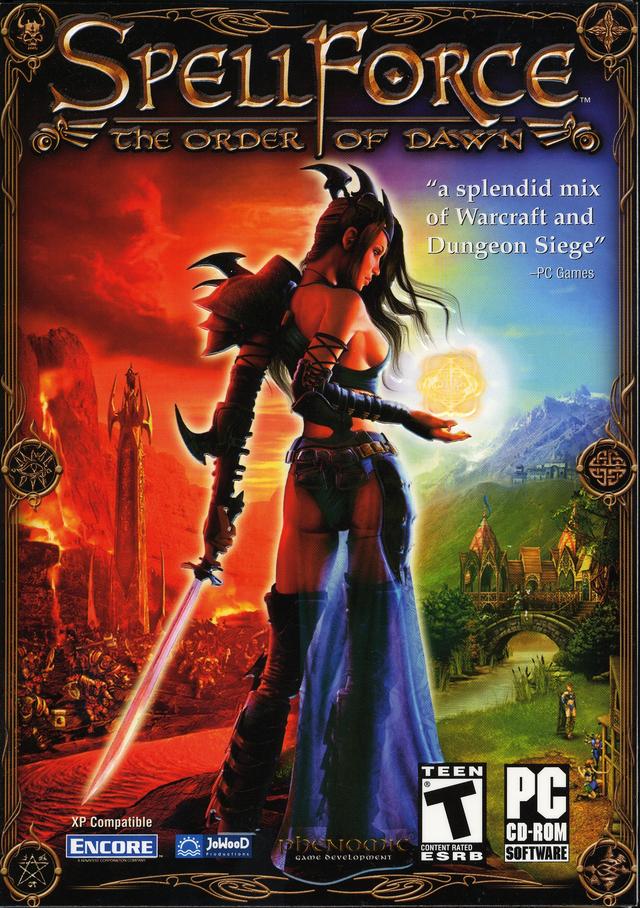SpellForce: The Order of Dawn Review
-
Category: ReviewsHits: 6791

Article Index
Page 1 of 2
Seems like the greatest idea in the world: take two very popular game genres and put them together in a game that will appeal to the fanbases of both. How could you lose? The problem is that it's monumentally hard to blend two genres without diluting the cult-creating aspects of one or both in the process. JoWood Production's recent release Spellforce: the Order of Dawn comes so close to pulling it off that I almost hate to talk about its flaws out of respect for the thoughtfulness with which developer Phenomic made the attempt.Predominantly a real-time strategy game, Spellforce is set in a high fantasy world and offers much more in the way of role-playing than many so-called RPGs. Like most RTS games, you receive near god-like control over a group of people whom you'll use to complete your goals, but instead of taking the role of armchair general, you'll create a character who will serve as your avatar and directly affect what goes down on the front-lines. Unfortunately, you can only play as a human (although you will be able to lead orcs, trolls, dark elves and the like later in the game), but you can choose to be male or female and whether you want to focus on magic or combat.
Beyond those restrictions, though, you can pretty much tweak your character as you desire. Each time you level up you will get points to spend on raising your abilities - standard things like strength, dexterity, wisdom, etc. - and on skills that improve your ability to use weapons, wear armor, and cast spells. You'll need to pay attention to which direction you are taking your character because you'll pick up many items during the game and most have very specific criteria as to what skills and abilities are needed to use them.
As a fan of both genres, I thought that the concept of a customizable avatar worked well. Finding items on corpses and tweaking your character to fit your play-style were a welcome distraction from the tedium of building a military economy by farming resources. Conversely, farming resources and building an army were a nice way to divert oneself from the boredom of level grinding. If you haven't had much experience with either genre, though, I could see how all the various goals you are juggling could become overwhelming, especially if you don't have much experience with RTS games.
I found myself using the role-playing aspect as more of a diversion and amusement and relying more on the skills I'd learned playing RTS games like Age of Kings, Starcraft, and Empire Earth to actually move the story forward. Most of the scenarios involve your character needing to get to a town, or to speak to someone, but needing to build up an army to destroy the orcs blocking his path beforehand. There are parts of the game where your avatar will be working solo, or fulfilling a quest, but for the most part, building an army to sack your enemy's is the order of the day.
Thankfully, managing your economy is not the micro-management nightmare that you often find in RTS games. Granted, there are a ridiculous amount of things that you can harvest and some can only be harvested by certain races. The full list is: wood, stone, iron, food, moonsilver, aria, and lenya. However, your peons for the most part are set-and-forget. After harvesting some wood, for instance, you can build a woodcutter's hut. Click on the hut and you will be able to assign up to five idle workers to it. Those workers then become lumberjacks. That's all pretty standard, but the nice thing about the Spellforce system is that if a lumber jack runs out of wood in his vicinity, he'll resume cutting once some trees grow back instead of waiting for you to tell him to chop wood again.
Building your army involves the standard practice of saving up resources to build a specific building and then training up soldiers until you get enough to take your enemy's base. What's unique to Spellforce is the rune system, where once you find a rune that represents a certain type of warrior, you can always build that type as long as you have built his training building. This system helps mitigate the redundancy that plagues the campaigns of many RTS games which seem to constantly put you back to square one, having to research the same technology several times over the course of the campaign.


